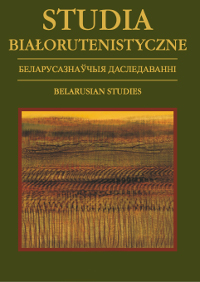Фемінатыўныя варыянты як марфалагічныя
інавацыі ў гаворках паўночна-ўсходняй Польшчы
(на прыкладзе ізаморфы kłomel f.)
Feminative Variants as Morphological Innovations in the Dialects of North-East Poland
(on the example of the isomorph kłomel f
Author(s): Natalia SnigiriovaSubject(s): Language studies, Language and Literature Studies, Eastern Slavic Languages
Published by: Wydawnictwo Naukowe Uniwersytetu Marii Curie-Sklodowskiej
Keywords: area; contact zone; language influence; stimulus; expansion; innovation
Summary/Abstract: Dialectal peculiarities in the functioning of the grammatical category of gender, characteristic of the north-eastern dialects of the Polish language, can be geographically and typologically correlated with the corresponding phenomena localized mainly in the north- and south-western Belarusian dialects – the areas of the individual feminine nouns continue in the East of the Polish language continuum. Assuming that the centre of irradiation or the stimulus that caused the appearance of the morphological innovation kłomel (f.), noted in the North-East of Poland, is hypothetically located in Belarus, in the area of expansion of the Polesie dialects, the author presents some results of a comparative analysis of data regarding the variable category of gender in Polish, Belarusian and some other Slavic and non-Slavic languages, as well as linguistic-geographical, structural-semantic, etymological data regarding this areal innovation with available Slavic and non-Slavic material, which allows us to get closer to solving its origin and the reasons for its appearance in the north-eastern speeches of Poland, where the lexeme kłomel (f.) is formally related primarily to the masculine word structure and is used alongside the well-known feminine equivalent kłomla. The research was conducted with the application of comparative, comparative-historical, descriptive-analytical and areal-typological methods. Their complex application leads to the conclusion that the Western Polesian-Panmonian word klomla should be interpreted as a stimulus phenomenon for the formation of the morphological innovation kłomel (f.) in the north-eastern dialects of the Polish language. The expansion of femininum in this case can be considered as the result of the redistribution of feminine and masculine forms in the inter-Slavic and Baltic-Slavic contact zone, which in turn caused changes in morphology and corresponding mutations in the considered lexeme.
Journal: Studia Białorutenistyczne
- Issue Year: 1/2022
- Issue No: 16
- Page Range: 221-235
- Page Count: 15
- Language: Belarusian

